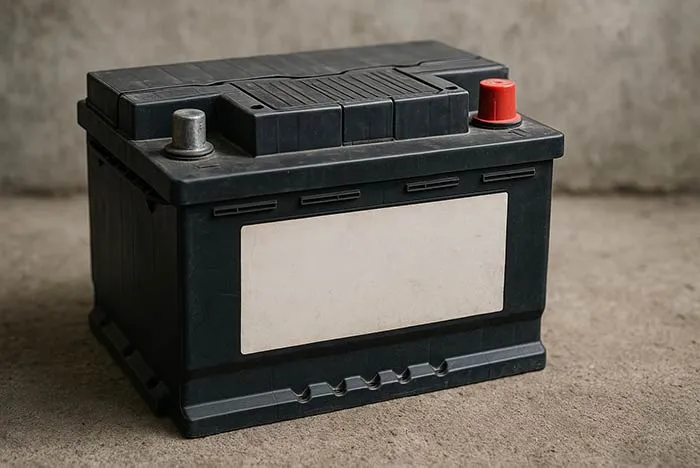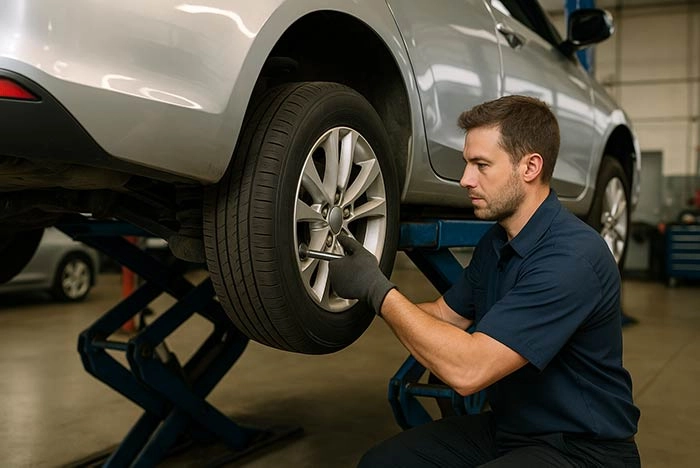
The simplest explanation of tire rotation is to prevent uneven tire wear and keep your car running straight. The idea is to change each tire to a different position, usually front to back or side to side. Why? Because tires wear out at different rates depending on their position. Front tires wear faster on front-wheel drive cars. On all-wheel drives, uneven wear can strain the system.
Ignoring rotation leads to bald spots, worse traction, and earlier replacements. Doing it regularly spreads the wear more evenly. That means better grip, smoother handling, and longer tire life. It also saves money in the long run.
This guide breaks down what tire rotation does, how often you should do it, and how to rotate tires at home or in the shop. We’ll also cover rotation patterns for FWD and AWD vehicles, explain if tire balancing is needed, and give you the real scoop on cost and time.
Whether you're driving a commuter car, SUV, or electric vehicle, rotating your tires is a smart habit. Let’s get into why and how it’s done right.
What Is Tire Rotation and What Does It Do?
Tire Rotation means changing the position of each tire on your vehicle at regular intervals. The idea of this activity is to evenly out wear and eventually extend the life of all four wheels.
Tires wear unevenly depending on their location. On front-wheel drive (FWD) cars, the front tires handle most of the braking, steering, and power delivery. That makes them wear faster than the rears. On rear-wheel drive (RWD) and all-wheel drive (AWD) vehicles, wear is more balanced but still uneven. Weight distribution, cornering, and alignment issues can all cause one area to wear quicker.
Here’s what tire rotation actually does:
✅ Balances wear – Rotation spreads out the stress, so all tires wear at a similar rate.
✅ Improves handling – Even tire wear helps maintain predictable grip in turns, braking, and wet conditions.
✅ Extends tire life – Instead of replacing two worn tires early, you get more miles from the whole set.
✅ Protects drivetrain – For AWD systems, mismatched tire wear can damage the transfer case or differentials.
✅ Saves money – Fewer early replacements. Better fuel efficiency. Less risk of sudden tire failure.
A typical rotation pattern moves the front tires to the rear and the rear tires to the front, often crossing them from side to side. But the right pattern depends on your car's drivetrain, tire type, and tread design. We’ll go over all that in the next sections.
How Often Should You Rotate Tires?
Most vehicles need a tire rotation every 5,000 to 8,000 miles—that’s about 8,000 to 13,000 kilometers. Some automakers say up to 10,000 miles (16,000 km) is fine, but shorter intervals are safer, especially if you drive aggressively, tow, or often carry heavy loads.
If you’re getting oil changes around every 5,000 miles (8,000 km), that’s the perfect time to rotate your tires too.
Here’s a quick guide by drivetrain:
| Drivetrain Type | Rotation Interval | Reason | Visual Guide |
|---|---|---|---|
| Front-Wheel Drive (FWD) | 5,000-7,500 miles (8,000-12,000 km) | Front tires experience more wear from steering, braking, and power delivery |  |
| Rear-Wheel Drive (RWD) | 6,000-8,000 miles (9,500-13,000 km) | Rear tires handle more weight and driving force, leading to unique wear patterns |  |
| All-Wheel Drive (AWD) | 5,000-6,000 miles (8,000-9,500 km) | Even tire wear is crucial to prevent drivetrain stress and maintain optimal performance | 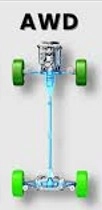 |
Rotate more often if:
❗ You see uneven tread wear
❗ You drive on rough or unpaved roads
❗ You use soft-compound or performance tires
❗ You feel pulling or vibration while driving
Always check your owner’s manual for the manufacturer’s recommendation. Some tires, like staggered setups or directional tread patterns, may have special rules.
Skipping rotations shortens tire life and can mess with your car’s handling. Once the wear is uneven, it’s too late—no rotation can undo the damage. Stick to the schedule to keep your tires and your ride in good shape.
How to Rotate Tires (Step-by-Step DIY Guide)
Rotating your tires at home is easier than it sounds. With a few basic tools and some time, you can do it yourself and save money. Here's how.
What You’ll Need
🔧 A car jack (hydraulic floor jack is best)
🔧 Jack stands (never rely on the jack alone)
🔧 A lug wrench or impact wrench
🔧 A torque wrench (for proper re-tightening)
🔧 Your owner’s manual (for torque specs and tire rotation pattern)
Step 1: Park and Prep
🚘 Park on level ground. Engage the parking brake.
🔧 Loosen lug nuts on all wheels slightly—but don’t remove them yet.
🔁 Look up the correct rotation pattern for your drivetrain.
Step 2: Lift the Car
🪜 Use the jack to raise one corner of the car.
🧱 Place a jack stand under the vehicle's frame.
🔄 Repeat for the other corners until all tires are off the ground and the car is secure.
Step 3: Remove the Wheels
🛞 Fully remove lug nuts and take off all four wheels.
📦 Keep lug nuts for each wheel together so nothing gets mixed up.
Step 4: Rotate According to Drivetrain
For Front-Wheel Drive (FWD)
- Move front tires straight to the rear.
- Move rear tires to the front, switching sides (rear-left to front-right, rear-right to front-left).
For Rear-Wheel Drive (RWD)
- Move rear tires straight to the front.
- Move front tires to the rear, switching sides.
For All-Wheel Drive (AWD)
- Use a rearward cross pattern:
- Rear tires go to the front on the same side.
- Front tires move to the rear and switch sides.
Note: If you have directional tires (tread only works one way), rotate front to rear only on the same side. No crossing.
If you have staggered tires (different sizes front and back), you may need to swap side-to-side only—check your manual.
Step 5: Reinstall and Torque
🔙 Put the wheels back on.
🤚 Hand-tighten each lug nut in a crisscross pattern.
⬇️ Lower the car slowly.
🔩 Use a torque wrench to tighten lug nuts to the spec in your manual—usually between 80–100 lb-ft (108–135 Nm).
Step 6: Final Checks
⚠️ Check tire pressure. Adjust if needed.
🔁 Reset your tire rotation reminder (if your car has one).
🚗 Take a short drive and recheck lug nut tightness after about 25 miles (40 km).
Rotating your own tires takes about 30 to 60 minutes, depending on experience. Once you’ve done it a few times, it gets quicker.
How to Rotate Tires on a Front-Wheel Drive Car
Front-wheel drive (FWD) vehicles put extra pressure on the front tires. They handle acceleration, steering, and most of the braking, which causes them to wear faster than the rears. That’s why regular rotation is critical for FWD cars.
Recommended FWD Rotation Pattern
Use the forward cross pattern:
- Front tires move straight back to the rear.
- Rear tires move diagonally forward, swapping sides.
Example:
| Front-left → Rear-left Front-right → Rear-right Rear-left → Front-right Rear-right → Front-left | 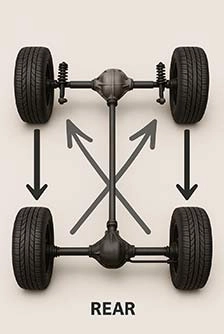 |
|---|
This pattern helps balance both the wear and the load stress on each tire over time.
Why Not Just Swap Front and Back?
Because the rear tires usually have less wear and more even tread. Moving them to the front and switching sides evens out any side-specific wear (like from cornering). Simply going front-to-back may still leave you with uneven wear in the long run.
When to Rotate FWD Tires
Stick to every 5,000 to 7,500 miles (8,000 to 12,000 km). If you notice:
- Tread depth differences front vs. rear
- Road noise increases
- Vibration in the steering wheel
…it’s time to rotate, even if you haven’t hit the mileage yet.
Pro Tip
If you buy new tires just for the front, they’ll wear out faster than the old ones in the back unless you start rotating early. Always rotate within the first 5,000 miles (8,000 km) of installing new tires.
How to Rotate Tires on an AWD Car
AWS All-wheel drive systems output power to all 4 wheels, which you might think would wear all the tires evenly. But in reality, tire wear still varies between front and rear or inner and outer tread. That really depends on the driving style and the suspension setup.
Keep in mind that usually the AWS are very sensitive to tire size differences. Uneven wear between tires can actually damage the distribution gearbox jeep.
Why Tire Rotation Matters More on AWD
AWD systems rely on tires being the same diameter. A small variation from wear can make the system think one wheel is slipping, causing unnecessary engagement of differentials or transfer cases. That leads to:
- Increased wear on AWD components
- Poor handling and traction
- Expensive repair bills
Regular tire rotation keeps wear even and avoids these problems.
Recommended AWD Rotation Pattern: Rearward Cross
This is the safest go-to pattern for most AWD vehicles:
- Rear tires move to the front on the same side
- Front tires move to the rear and switch sides
Example:
| Rear-left → Front-left Rear-right → Front-right Front-left → Rear-right Front-right → Rear-left | 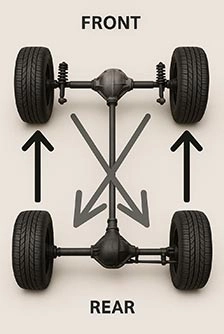 |
|---|
This pattern helps balance front/rear wear while managing the side-to-side stress from cornering.
How Often to Rotate Tires on AWD Cars
Rotate every 5,000 to 6,000 miles (8,000 to 9,500 km)—no exceptions. If you wait too long, you might need to replace all four tires early, just because one is too worn down to match the others.
Things to Watch For
- Directional tires? → Rotate front-to-back, same side only. No crossing.
- Staggered wheels (different sizes front/rear)? → You might only be able to rotate side-to-side. Check the manual.
- Aggressive off-road use or towing? → Rotate more often. Every 3,000 to 5,000 miles (4,800 to 8,000 km) is safer.
AWD tire rotation isn’t just about tread life—it’s about keeping your drivetrain healthy. Skip it, and you’re risking more than just a worn tire.
Is Tire Rotation Necessary for AWD Vehicles?
Yes—tire rotation is absolutely necessary for AWD vehicles. In fact, it’s even more important than on front- or rear-wheel drive cars. Here’s why.
AWD Systems Rely on Even Tire Size
AWD works by sending power to all four wheels. If one tire wears faster than the others, it changes the rolling diameter. That difference confuses the system.
The drivetrain senses one wheel spinning slightly faster or slower. It reacts by adjusting torque—even when there’s no actual wheel slip. Over time, this puts strain on expensive parts like:
- The center differential
- The transfer case
- The viscous coupling
- Electronic AWD clutch packs
Worn tires can trick the system into thinking a wheel is slipping. That leads to unnecessary engagement—and eventually, failure.
Even 2/32" (1.6 mm) Can Cause Damage
That’s not a typo. A 2/32 inch (1.6 mm) difference in tread depth across tires is enough to cause problems in many AWD systems. Once the wear gap hits that level, the only fix may be replacing all four tires—even if only one is worn.
Skipping Rotation = Expensive Repairs
Replacing an AWD transfer case or differential can cost anywhere from $1,000 to $3,000+. Rotating your tires every 5,000 to 6,000 miles (8,000 to 9,500 km) costs next to nothing by comparison.
Real-World Tip
If you’re buying just two new tires for an AWD vehicle (because the other two still have decent tread), ask a shop to shave the new ones down to match the existing tread depth. Yes, tire shaving is a real service—and it’s cheaper than buying four new tires.
Tire rotation keeps your tread wear even and your AWD system working right. It’s not just about saving tires. It’s about saving your drivetrain too.
Do You Need to Balance Tires Every Time You Rotate Them?
No, you don’t need to balance your tires every time you rotate them. But it depends on what you’re noticing when you drive.
What’s the Difference Between Rotation and Balancing?
- Tire rotation is just moving the tires to different positions on the car.
- Tire balancing adjusts the weight distribution around each tire and wheel assembly. It corrects small imbalances that cause vibrations.
When Is Balancing Needed?
You should balance tires if you notice any of the following:
🔄 Steering wheel shakes at certain speeds
🌐 You feel vibration in the seat or floor
🛞 Tires have uneven or scalloped tread wear
🩹 You just had a tire patched or repaired
🆕 New tires were installed without balancing
If your car drives smooth after rotation and there’s no vibration, you probably don’t need balancing.
Best Practice
While balancing isn’t required every time, many shops offer it as part of a tire rotation service—especially if it's included in a tire purchase package. It’s cheap insurance.
Some drivers choose to balance tires every other rotation (about every 10,000 to 12,000 miles / 16,000 to 19,000 km). That’s a safe rule unless you start feeling a shake.
How Much Does Tire Rotation Cost?
Tire rotation is one of the cheapest services you can get for your car—especially compared to what it saves you in the long run.
Typical Tire Rotation Cost (U.S. Averages)
- At a tire shop or dealership:
$20 to $50 total for all four tires - As part of a tire package:
Often free if you bought the tires there - DIY rotation:
Free—just your time and tools
What Affects the Price?
- Vehicle type – Trucks, SUVs, or AWD cars with larger or staggered wheels may cost more.
- Wheel design – Some cars with locking lugs or TPMS sensors might take longer.
- Where you go – Dealerships often charge more than independent tire shops or national chains.
- Extras included – Some shops bundle in balancing, tire pressure checks, or brake inspections.
Free Tire Rotations – Where to Get Them
- Tire retailers like Discount Tire, Costco, and Les Schwab offer free lifetime rotations if you buy tires there.
- Some auto repair chains include rotations with oil changes or service plans.
Always ask before paying—there’s a good chance you’re already covered.
DIY Tire Rotation Costs
Doing it yourself can save money, but you’ll need:
- A jack ($30–$100)
- Jack stands ($30–$60)
- A torque wrench ($40–$100)
How Long Does a Tire Rotation Take?
Tire rotation doesn’t take long—typically 30 to 60 minutes, depending on how it’s done and who’s doing it.
At a Tire Shop or Dealership
- 15 to 30 minutes if it’s a quick in-and-out job
- Up to 60 minutes if they’re busy or combining it with other services (like an oil change or inspection)
- Some places offer walk-in service, while others may need an appointment
If balancing is included or extra services are added, expect a longer wait.
DIY Tire Rotation Time
- 45 to 60 minutes if you’re doing it the first time
- 30 minutes or less once you’ve done it a few times and have the right tools
It can take longer if:
- You don’t have a floor jack or use the car’s scissor jack
- Lug nuts are stuck or require special tools
- You’re rotating complex setups (like AWD or staggered wheels)
Tips to Save Time
- Use an impact wrench to speed up lug nut removal
- Have all tools ready: jack, jack stands, torque wrench, gloves
- Park on a flat, open surface for easier access
- Loosen all lug nuts before lifting the car
For something that takes less than an hour, tire rotation gives a big return. You extend tire life, improve safety, and avoid future problems—without spending much time.
FAQ – Common Tire Rotation Questions
Can Tire Rotation Fix Vibration?
Not usually. If you feel vibration after rotating your tires, it’s likely due to an existing imbalance that became noticeable when the tires were moved. In such cases, balancing the tires can often resolve the issue. Some drivers have reported that rotating tires back to their original positions eliminated the vibration, indicating that the problem was related to tire balance or wear patterns. Bob Is The Oil Guy
Should Tires Be Rotated After Alignment?
Tire rotation and wheel alignment are separate maintenance tasks. Rotating your tires does not affect alignment settings. However, if your vehicle shows signs of misalignment, such as uneven tire wear or pulling to one side, it's advisable to get an alignment check. Regular alignment checks, approximately every 40,000 to 50,000 miles (64,000 to 80,000 km), or after significant impacts like hitting potholes, are recommended. Zappy's Auto Washesacurazine.comCar Talk Community
What If I Skipped Tire Rotations for 20,000 Miles?
If you've missed rotations for 20,000 miles (32,000 km), your tires may have developed uneven wear patterns. While it's still beneficial to rotate them to promote even wear moving forward, be aware that existing irregular wear won't be corrected by rotation alone. In some cases, increased road noise or reduced ride comfort may occur after a delayed rotation. Wikipedia+3Christian Brothers Automotive+3PriusChat+3Swedespeed
Do Electric Cars Need Tire Rotation More Often?
Yes. Electric vehicles (EVs) are heavier and deliver instant torque, leading to faster tire wear, especially on the front tires. Regular rotation, every 5,000 to 8,000 miles (8,000 to 13,000 km), helps ensure even wear and extends tire life. Some EV manufacturers, like Tesla, recommend rotations every 6,250 miles (10,000 km) or when tread depth differences reach 2/32 inch (1.6 mm). SpeakEv
Is Tire Rotation the Same as Wheel Alignment?
No. Tire rotation involves moving tires to different positions on the vehicle to promote even wear. Wheel alignment adjusts the angles of the wheels to ensure they are set to the manufacturer's specifications, which affects how the tires contact the road. Both are essential for tire longevity and vehicle handling but serve different purposes.
